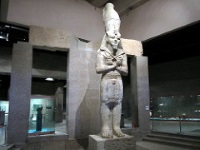
The two temples of Abu Simbel - the Temple of Ramses II and the Temple of Hathor (the Sun God), dedicated to his wife Nefertari - were cut out of the sandstone cliffs more than 3,000 years ago. Not only are these ancient temples among the most magnificent in the world, but their removal and reconstruction are recorded as an impressive engineering feat. The temples were relocated, very successfully, during the construction of the High Dam on Lake Nasser in the 1960s. The monuments were threatened with submersion, and after an appeal by UNESCO, in co-operation with the Egyptian Government, they were dismantled and reassembled exactly as before, about 197 feet (60m) higher up.The intimidating sight that first greets the visitor at Abu Simbel is that of the four colossal statues guarding the entrance to the Grand Hall of the Temple of Ramses. The interior is highly decorated with relief paintings and is supported by eight statues of Ramses acting as giant pillars. Leading off the hall are painted sanctuaries and chambers. The Temple of Hathor is smaller and simpler, also with statues guarding the entrance and a manifestation of the Sun God portrayed above. It is aligned in such a way that the sun's rays reach inside to illuminate the statues of Amun-Re, Ramses II, and Re-Horakhty twice a year. The statue of Ptah, a god of the underworld, remains in shadow. The temples are considered to be the grandest and most spectacular monuments built during the reign of Ramses II.

The Nubia Museum in Aswan is an excellent introduction to the history and culture of the Nubians. It contains a collection of artefacts from Nubia (the region approximately between Aswan and Khartoum in Sudan) and an exhibition of Nubian culture and crafts. It also portrays the history and people of the Nile Valley from ancient times until the present, and has a hall full of impressive statues and tombstones from the region.One of the most interesting exhibits is that covering the project of UNESCO to move monuments like Abu Simbel, endangered by the High Dam on Lake Nasser, to higher ground. Visitors can get an idea of what the area looked like before the floods and how much effort was put into preserving this endangered ancient culture. At the Nubia Museum you can see weaponry, pottery, jewellery, statues and the ever-popular mummies. The exhibits are well organised and laid out and have good English labels. The museum is well air-conditioned, making it a popular retreat from the heat of the day. It is also open until late, providing a good option for an evening of culture.
Address : el Fanadek Street (Opposite Basma Hotel)

The main place of worship in Theban times, and built over a period of 1,300 years, the massive Temple of Karnak in Luxor is an incredibly impressive structure. It was known as Ipet-isut, the most select of places, to the ancient Egyptians and it is one of the largest religious buildings ever erected. One of the world's great architectural achievements, the Hypostyle Hall, is filled with immense stone pillars still bearing the engraved and painted inscriptions from the 12th Dynasty, and covers an area of 64,583 square feet (6,000 sq metres). The complex also contains the Avenue of the Sphinxes, the Sacred Lake, and many huge statues, halls, ornate wall murals, obelisks and colonnades.One of the lesser known attractions of this vast temple complex is the small Temple of Ptah, hidden on the northeastern boundary. It is very special because the room is intact - giving a realistic sense of what the dark temple interior would have felt like in ancient times - and a statue of Sekhmet remains in place, lit up by natural light. The Temple of Karnak can be a bit overwhelming without a guide, or at least a good guide book, so be sure to either hire someone or do your research to fully appreciate the wonders of the place.

The West Bank is an area of limestone hills and valleys riddled with tombs and temples across the river from Luxor. Goats roam freely among the ruins, and the tiny settlements on the slopes provide a splash of colour in an otherwise desert-like barrenness. The 59 foot (18m) high pair of enthroned statues of the Colossi of Memnon are the first things most visitors will see on the West Bank. These are the only remaining structures of the mortuary temple of Amenophis III.Most travellers come to visit the Valley of the Kings, where the secretive tombs of the Pharaohs were built to immortalise their mummies and treasures for eternity. In an attempt to thwart tomb robbers, traps and deceptions were part of the architectural planning. Dramatic descents, spectacular murals on the passage and chamber walls and a replica of the original sarcophagus at the end of the tunnel create an awe-inspiring atmosphere. There are a number of areas and tombs to explore and highlights include the tombs of Tutankhamun and Ramses II. However, the country's finest tomb, the Tomb of Nefertari, lies in the Valley of the Queens, which has exceptional painted murals. Nefertari's tomb is open to the public after a restoration project. However, only small groups are admitted at a time, and each visitor must pay 1000 Egyptian Pounds (about $56). Also worth a visit is Hatshepsut's Temple, the mortuary temple of Egypt's only female Pharaoh.

Travel Guide powered by Word Travels, copyright © 2023 Globe Media Ltd. By its very nature information in this travel guide is subject to change at short notice and travellers are urged to verify information on which they're relying with the relevant authorities. Neither Globe Media Ltd nor Travel Vogue can accept any responsibility for any loss or inconvenience to any person as a result of information contained above.